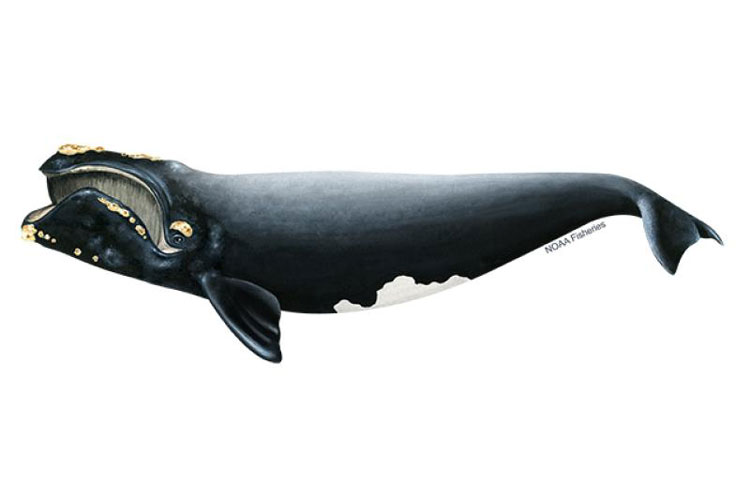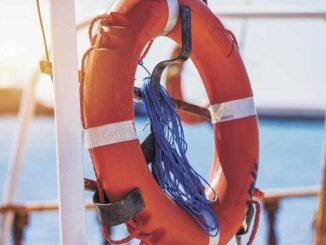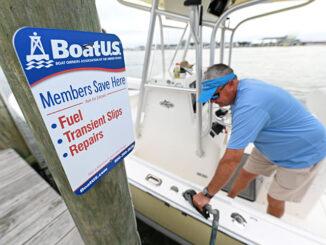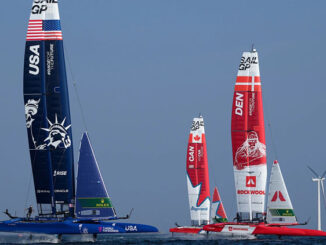
Cover photo: Right whale #3853 swimming north offshore of South Carolina on Jan. 20, 2011 with a series of fresh propeller wounds running across its back. The whale was observed 5 days previously offshore of Georgia without propeller wounds. It is unknown whether the whale survived its wounds or not, as it has not been re-sighted since. Vessel collisions are a leading cause of right whale mortality. Credit: EcoHealth Alliance (NOAA permit #594-1759).
The North Atlantic right whale is one of the world’s most endangered large whale species; the latest preliminary estimate suggests there are fewer than 350 remaining. Two other species of right whales exist, the North Pacific right whale, which is found in the North Pacific Ocean, and the Southern right whale, which is found in the southern hemisphere. Right whales are baleen whales, feeding on copepods (tiny crustaceans) by straining huge volumes of ocean water through their baleen plates, which act like a sieve.
By the early 1890s, commercial whalers had hunted North Atlantic right whales to the brink of extinction. (They got their name from being the “right” whales to hunt because they floated when they were killed.) Whaling is no longer a threat, but they have never recovered to pre-whaling numbers, and human interactions still present the greatest danger to this species. Entanglement in fishing gear and vessel strikes are the leading causes of North Atlantic right whale mortality. Increasing ocean noise levels from human activities are also a concern since the noise may interfere with right whale communication and increase their stress levels.

A new proposed rule aims to reduce vessel strikes and add protections to endangered North Atlantic right whales. The proposed changes would expand mandatory speed restrictions to include vessels 35 to 65 feet long and broaden season speed restriction zones.


Reducing vessel strikes to North Atlantic right whales
More information on North Atlantic right whale vessel speed restrictions to reduce the likelihood of lethal collisions between vessels and these endangered whales.
On a recent episode of Dive In with NOAA Fisheries (See the transcript below), NOAA talked with Dr. Caroline Good, a large whale ecologist and the lead on right whale vessel strike-related issues.
Slowing Down to Save North Atlantic Right Whales
00:00:00 (John Sheehan)
One evening in February 2021, Captain Shane Ryan was returning to port in St. Augustine, Florida with his eight-person fishing party. The fifty-four foot sport fishing boat named About Time was near the inlet, cruising at about twenty one knots when suddenly the boat slammed to a halt. They had hit something.
00:00:21 (Shane Ryan)
We hit an object in the inlet here and we are taking on water.
00:00:26 (John Sheehan)
The rear of the vessel lifted out of the water. The engine stalled. Part of a propeller had pierced the hull. Captain Ryan was able to steer the ship into the shallows and beach it as they waited for help to arrive.
00:00:38 (Shane Ryan)
Coast Guard, we are on the beach. We are definitely on mud.
00:00:43 (John Sheehan)
What they couldn’t know then was that the About Time had struck a North Atlantic Right Whale calf and its mother. By the next morning, the calf had washed ashore dead.
00:00:52 (News broadcaster)
Had propeller wounds. The mother of that calf was found alive days later with similar wounds.
00:00:57 (John Sheehan)
The mother nicknamed “Infinity” hasn’t been seen since. The ship, the 1.2 million dollar vessel was a total loss. This story, and more like it give reason to a new proposed rule that aims to reduce these kind of vessel strikes and add protections to North Atlantic Right Whales. This is Dive In with NOAA Fisheries. I’m John Sheehan. Today we’ll hear about the proposed regulation, who it will impact, and how it can help. The proposal is open now for public comment. And whether you are a boater, a coastal resident, or just someone interested in conservation, you should absolutely weigh in and help craft these regulations. You’ll hear how a little later. To back up a second, let’s remind ourselves a little bit about North Atlantic Right Whales.
00:01:46 (Dr. Caroline Good)
The species is found in the northwest Atlantic Ocean. Their range is generally from Florida to coastal Canada.
00:01:54 (John Sheehan)
And most importantly.
00:01:56 (Dr. Caroline Good)
North Atlantic Right Whales unfortunately are in very, very bad shape. Our best estimates indicate that there are fewer than three hundred and fifty individuals left in the population and approaching extinction.
00:02:07 (John Sheehan)
This is my guest, Doctor Caroline Good, a large whale ecologist and the lead on Right Whale vessel strike related issues. She works in NOAA Fisheries Office of Protected Resources.
00:02:19 (Dr. Caroline Good)
The primary threats right now for Right Whales are human related. And these include entanglement in fishing gear and vessel strikes.
00:02:27 (John Sheehan)
Today we’re talking about the second of those human related threats, vessel strikes.
00:02:32 (Dr. Caroline Good)
All large whale species are susceptible to vessel strikes. And they sustain generally two different types of injuries. One is blunt force trauma from coming into contact with a hull or propeller. And the second are laceration injuries, again, from coming into contact either with a sharp part of the hull or again, usually the propeller.
00:02:56 (John Sheehan)
These strikes and the high number of deaths they’ve caused in the U.S. and Canada led NOAA scientists to declare a UME, or “unusual mortality event.”
00:03:06 (Dr. Caroline Good)
Since 2017 the Right Whale UME includes fifty events. And these are fifty both mortalities and what we call serious injuries, an injury that is bad enough that the animal is more likely than not to die from that injury. And for such a small population you can imagine, you know, fifty events in a year. I mean, that’s a lot to have had since 2017.
00:03:31 (John Sheehan)
Just a quick note here. Since I recorded this interview with Caroline, that number has already gone up.
00:03:37 (Dr. Caroline Good)
In fact, the sole source of mortality for juveniles and adults that we have detected in Right Whales over the past twenty years is human related, meaning that juveniles and adults are never living long enough to actually ever be documented to die of natural causes.
00:03:55 (John Sheehan)
Now there’s an existing rule that was meant to address these vessel strikes. It was established in 2008 and very broadly says that boats over sixty-five feet in length have to transit at ten knots, or roughly twelve miles per hour. In certain areas and at certain times in zones up and down the east coast. But here’s the thing about that existing rule.
00:04:18 (Dr. Caroline Good)
It is helping to a degree but we’re missing the mark. We’re still continuing to have strikes. There is a mis-alignment between where these seasonal speed restriction areas area and where the risk is occurring along the U.S. coast.
00:04:33 (John Sheehan)
Vessel strikes are happening outside of the current reduced speed zones. The whales are changing up their migration patterns and foraging for food in new and different places at least partly due to climate change. And we know this thanks to all the research, observation, and data collection that’s happened since 2008.
00:04:51 (Dr. Caroline Good)
The second issue has to with the vessels that are subject to speed restriction. Another thing that we have discovered is a problem with vessels under sixty-five feet striking and harming Right Whales. So, since 2005 we have eight vessel strike events involving vessels less than sixty-five feet. Six involved lethal injuries. And these are all occurring within U.S. waters. And so, it’s very clear that this smaller vessel size class is a real problem. And I think that would surprise many people. I think most people think of a vessel killing a whale has to be larger than the whale. And that’s not true. So, the proposed regulations would also add vessels. Again, most vessels within the thirty-five to sixty-five foot range.
00:05:41 (John Sheehan)
The About Time, the boat I mentioned at the beginning of the episode, was fifty-four feet long and plenty capable of killing a whale.
00:05:48 (Dr. Caroline Good)
The majority of vessels within that size class are recreational pleasure boats. But there are also all sorts of other passenger boats, and tour boats, and work, and industrial boats. So, there’s actually a fairly wide variety of vessel types that are in that size class. The largest vessels are almost always going to cause a lethal encounter with any animal. But the smaller a vessel gets, the more important a reduced speed may be in reducing the lethality of any kind of interaction. We believe that by slowing vessels, whales also may be better able to detect the vessel and avoid a collision themselves.
00:06:26 (John Sheehan)
Do we know between the new size limitations and the new seasonal zone recommendations how many boaters are we talking about?
00:06:34 (Dr. Caroline Good)
We’re estimating that the proposed changes may affect just under sixteen thousand vessels. However, I should note that we cast a pretty wide net when trying to estimate particularly those vessels under sixty-five feet how many of them may be impacted. So, we acted conservatively and pulled in vessels that may not actually regularly transit in these areas. But we would have rather, we would rather assume more impacts than less when considering the impacts to mariners out on the water.
00:07:06 (John Sheehan)
And I read that often times commercial boats are not designed to go much over ten knots anyway.
00:07:11 (Dr. Caroline Good)
Yeah. That’s actually a really important point because just because a vessel may be subject to a speed restriction doesn’t mean they’re really going to be affected or impacted by it. So, for example, we found in the data that we have for commercial fishing vessels, the vast majority of them already transit at or around ten knots regardless of whether those areas have active speed restriction or not. And you know it’s really interesting we’ve also seen an interesting trend of vessels particularly the largest ocean going vessels. So, these are big merchant vessels and cruise ships. Transiting at slower speed irrespective of any of our speed restrictions. And this may have to do with saving fuel. Fuel is very expensive. It’s a major cost for any vessel. And also, for the largest vessels there are requirements for emissions. And the entire east coast of the United States is what’s called an emissions control area. And so, transiting at slower speeds, again, can help you reduce a vessel’s individual emissions.
00:08:14 (John Sheehan)
Okay. We’ve talked a bit about which kinds of vessels would be impacted. But now let’s talk about where and when. And a reminder that the speed reduction zones already exist from the 2008 rule. And these changes would largely extend the existing areas. There are two kinds of zones being proposed: seasonal.
00:08:34 (Dr. Caroline Good)
These seasonal zones are put in place in areas with generally heavier vessel traffic, high levels of risk, persistent whale presence, and extend from Massachusetts all the way down to the northern coast of Florida. And they are primarily active between the months of November and April or May with one area to the east of Cape Cod remaining through June.
00:09:01 (John Sheehan)
And dynamic zones.
00:09:03 (Dr. Caroline Good)
In these zones are triggered outside of active seasonal areas if Right Whales are detected and there is a greater than fifty percent likelihood that the whales will remain within this dynamic zone while it’s effective. We have certain times of the year when whale presence is more unpredictable, or vessel strikes risk can sometimes be a bit lower. And so, this allows us some flexibility and nimbleness to address risk where and when it occurs. Also, you know, this allows flexibility for potential changes in Right Whale distribution particularly due to climate change.
00:09:41 (John Sheehan)
And what about in cases of emergency when a midsize vessel finds themselves in a speed zone, but something’s come up and they have to, they have to go above ten knots? Does the new proposal make accommodations for emergencies?
00:09:57 (Dr. Caroline Good)
Definitely. Vessel safety and mariner safety is very important. We are adding a particular provision for emergencies. So, let’s say you know, someone has broken their leg and a vessel needs to speed in to get someone to the hospital, that is now going to be included under that reasonable need to exceed ten knots. Additionally, we are adding a special weather provision for vessels under sixty-five feet cause we recognize they have different challenges operating in adverse weather than a large ship would. And so, for vessels in the thirty-five to sixty-five foot range if they are transiting within a mandatory speed zone but in an area where the national weather service has declared a gale warning or great wind warning like hurricane warning, they are going to be automatically exempt from any speed regulations to that they can, you know, make sure they get in safely to port.
00:10:50 (John Sheehan)
Lastly, Caroline made a great point about how vessel strikes often occur.
00:10:54 (Dr. Caroline Good)
Of the eight strikes that were reported involving vessels under sixty-five feet, seven of those eight vessels never saw the whale before they struck it.
00:11:05 (John Sheehan)
Captain Ryan, the captain of the boat that I mentioned earlier knew the area and was actively watching out for debris or obstacles. He was an experienced professional.
00:11:14 (Dr. Caroline Good)
The mariners who have reported striking large whales along the east coast are a wide variety of people. They are recreational boat operators, researchers, and in some cases, they were operating with professional observers. These are really responsible boaters who struck these animals.
00:11:34 (John Sheehan)
They’re just hard to see. And when you combine increased speed, low visibility, and a predilection for Right Whale mothers and calves to stay near the water’s surface, it can mean disaster for the whales and boaters.
00:11:48 (Dr. Caroline Good)
We also anticipate this is going to help other large whales in the Atlantic as well. There are a number of protected and endangered large whale species that occur along the U.S. Coast, and they overlap with these areas of high strike risk.
00:12:02 (John Sheehan)
It’s for all these reasons that the rule changes have been proposed. And we’d like to hear from you about it. NOAA Fisheries is accepting public comments now through September 30th, 2022 at the Federal Register, federalregister.gov. Or you can learn more at our website, fisheries. Noaa.gov.
00:12:21 (Dr. Caroline Good)
And we very much encourage public comment. There’s a lot of work that went into this. And we have a real crisis that we’re trying to address. So, we’re very eager to hear from the public of what they think, how they feel this may help Right Whales, and how they think this may impact vessel community.
00:12:37 (John Sheehan)
Doctor Caroline Good is a Large Whale Ecologist in NOAA Fisheries Office of Protected Resources. I’m John Sheehan. And this has been Dive In with NOAA Fisheries.
00:12:52 (Podcast ends)


